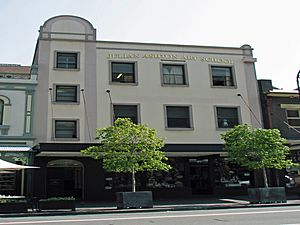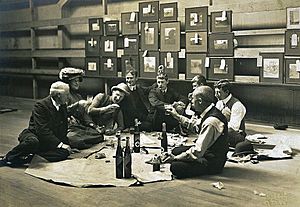Julian Ashton Art School (building) facts for kids
Quick facts for kids Julian Ashton Art School |
|
|---|---|

Julian Ashton Art School, pictured in 2018
|
|
| Location | 117-119 George Street, The Rocks, City of Sydney, New South Wales, Australia |
| Built |
|
| Built for |
|
| Architect |
|
| Owner | Property NSW |
| Official name: Julian Ashton Art School; Gallery and Shop | |
| Type | State heritage (built) |
| Designated | 10 May 2002 |
| Reference no. | 1556 |
| Type | Other - Commercial |
| Category | Commercial |
| Lua error in Module:Location_map at line 420: attempt to index field 'wikibase' (a nil value). | |
The Julian Ashton Art School is a famous art school located at 117-119 George Street in The Rocks, a historic area in Sydney, Australia. This building used to be offices and shops. It is now home to the Julian Ashton Art School and other retail stores.
The building was designed by E. Lindsay Thompson and Spooner & Dixon. It is also known as the Gallery and Shop. The property is owned by Property NSW, a government agency in New South Wales. The building was added to the New South Wales State Heritage Register on 10 May 2002. This means it is a very important historical site.
Contents
History of the Building
Early Days and First Owners
Before the area was divided into smaller plots, this land was part of a hospital area. The hospital buildings and doctors' homes were along George Street. They had gardens visible from the street.
A man named John Dalley, who was a convict, arrived in Australia in 1819. After the Sydney Hospital moved, he was given a piece of land. Within six years, he owned two nearby plots in The Rocks. He built a five-room house on one of these plots around 1832.
John Dalley's journey from convict to landowner was common in New South Wales. His son, William Bede Dalley, became a very successful lawyer and politician. It is likely that young William grew up in the house on this site.
From the mid-1800s, records show different businesses here. The street numbers changed in 1880-1881. What is now 117-119 George Street was once 119-121 George Street. Maps from the late 1800s show buildings like the British Flag Hotel and O'Neil Outfitters. Later, both buildings were known as the Queensland Hotel.
In 1900, the government took over the land. This was part of a larger plan to redevelop the Observatory Hill area.
John Fell & Co. and Building Changes
From 1902, John Fell & Co. occupied the entire site. They were a company that supplied oil, coal, and grease for industrial uses. Old photos show their company name on the doorways of both 117 and 119 George Street.
The company likely updated or rebuilt the front of the building. This would have given it the decorative style seen at the time. In 1931, John Wilson Fell bought the property from the government. This was unusual, as most properties in this area stayed government-owned. John Fell & Co. stopped trading here by 1948.
Women's League of Health
The building you see today was built in 1956. For many years, the main tenant was the Women's League of Health. This group later became known simply as the League of Health. Dorothea (Thea) Margaret Hughes bought the property in 1954. By 1973, the building was often called the League of Health Building.
The Women's League of Health was a group that taught physical training for women and children. They focused on helping women's health, especially during pregnancy. Thea Stanley Hughes started the Australian branch of this League. She believed in developing women's character through self-improvement, not just exercise. The League was very popular in Australia, with over 250 classes each week.
The League's work was part of "first wave feminism." This movement aimed to give women more freedom and independence. They wanted women to have roles outside of traditional social expectations. The League provided a way for women to connect and develop themselves.
The original building from John Fell's time was demolished. A new three-storey building was constructed in its place in 1956. This new building had a modern look with dark red bricks and large metal-framed windows.
Retail Shops and Art School
In 1971, the Sydney Cove Redevelopment Authority took over the building. In 1973, Flame Opals, a shop selling opals, moved in. It was one of the first businesses in The Rocks to focus on tourists. The owner, Mr. William Cudlipp, saw the potential in the area. Between 1973 and 1978, the ground floor was renovated. They added new display units, a mezzanine area, and a secure selling space.
The Julian Ashton Art School moved into the upper floors of the building in 1977. It had previously been located in the Geological and Mining Museum. The school uses large and small studios, an office, and a storage room. It also keeps its collection of artworks and plaster sculptures here.
Around 1985, the building's modern red brick front was changed. This was done to make it fit in better with the older buildings in The Rocks. Some front windows were bricked up, leaving three windows on each upper floor. The front was then covered with a smooth finish, making it look like an older building that had been updated.
In 1987, the lower floor was renovated again. A new awning was added to the front, along with a signboard and new door and window fittings. The Hogarth Gallery, which sold Aboriginal art, was the last tenant on the middle floor.
About the Julian Ashton Art School

The Sydney Art School, also known as the Julian Ashton Art School, is a very important art school in Australia. Julian Ashton started it in 1890 as the "Academy Julian."
Many famous Australian artists have studied at the Julian Ashton Art School. These include William Dobell, John Olsen, Brett Whiteley, and Nora Heysen.
Julian Ashton's grandson, J. Richard Ashton, and his wife Wenda ran the school from 1960 to 1977. During this time, artists like Ian Chapman and Archibald Prize winner Francis Giacco attended. Then, Phillip Ashton, Richard's son, became Principal. Famous students like political cartoonist Bill Leak and artist Paul Newton were there then.
In 1988, Paul Delprat, Julian Ashton's great-grandson and a former student, took over as Principal. In 1989, the school's old plaster casts and easels, which date back to 1890, were recognized by the National Trust of Australia. The school's main campus is in The Rocks, Sydney, across from the Museum of Contemporary Art Australia. The building is listed on the New South Wales State Heritage Register.
Archaeological assessments suggest that parts of the original 1830s buildings might still exist in the basement. This means there could be historical evidence of earlier structures on the site.
Why is it Heritage Listed?
The Julian Ashton Art School building at 117-119 George Street is important for several reasons. It is significant at a state level because it was the main office for the Women's League of Health. This Australian health and fitness movement aimed to empower women through physical activity and education. It strongly reflects the ideas of its founder, Thea Stanley Hughes.
The building itself is important because of its connection to the League. Its large, well-lit spaces were perfect for holding classes. The way the building's front was changed in the 1980s also shows how people thought about heritage conservation back then. It was an effort to make a modern building fit into a historic area.
The building's front now helps it blend in with other buildings on George Street. This adds to the historical importance of The Rocks Conservation Area. The early use of the building by Flame Opals is also part of the history of The Rocks becoming a tourist area.
The site's connection to John Dalley is important locally. He represents successful former convicts who became businessmen in The Rocks. There is also a strong link to feminist history in New South Wales because of the Women's League of Health. There might be archaeological evidence of older buildings and activities on the site, especially in the basement area.
The Julian Ashton Art School building was listed on the New South Wales State Heritage Register on 10 May 2002 because it met several important criteria:
- It shows the history of New South Wales: The building played a key role in the Women's League of Health. This movement was a significant part of "first wave feminism" in Australia. It provided social activity, exercise, and health information for women. The building's early use by Flame Opals also shows how The Rocks changed into a tourist area.
- It is linked to important people or groups: The building is strongly connected to the Women's League of Health and its founder, Thea Stanley Hughes. She was crucial in bringing and running this health movement in Australia. The site is also linked to John Dalley, a successful former convict, and his famous son, William Bede Dalley.
- It has special design or artistic features: The building's front on George Street is interesting. It shows how authorities tried to make a modern 1950s building look older to fit into a historic area. This design helps the streetscape of George Street look like a mix of old and new architecture.
- It is important to a community or cultural group: The site has a strong connection to feminist history in New South Wales because of the Women's League of Health. It may also be important to groups interested in women's rights and their development in Australia.
- It can provide historical information: The site may contain archaeological evidence from as far back as 1832. This could help us understand how the buildings were constructed and what life was like in The Rocks and Sydney over time.
- It has rare or unique historical aspects: While the original building style was common, its modified front is quite rare. It shows a unique attempt to make a modern building look historic in a sensitive area. Also, it's unusual for a health or fitness group like the Women's League of Health to be so directly linked to one specific building.

